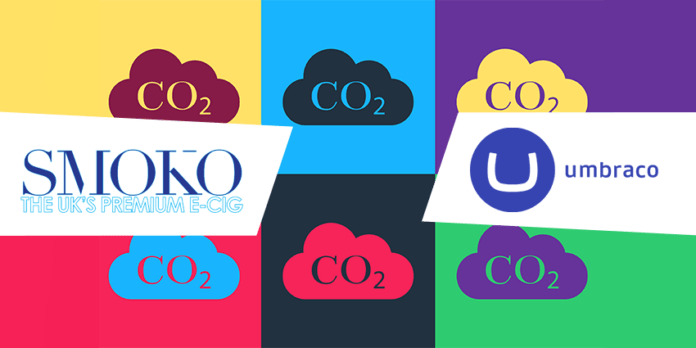While you may know that you should be doing something about emissions, it can be difficult to know what exactly what action to take.
Along with which football team is best, whether that dress is blue or gold, and Brexit, the climate emergency can be one of the more contentious topics of conversation.
But when 40-degree heat sparked grass fires that burnt down houses in the southeast of the UK, 2022 may have been a tipping point in public opinion. In fact, almost two-thirds (64%) of adults in Great Britain said they were worried about the impact of climate change in the past 12 months, according to the Climate Change Insights, Health and Well-being in the UK published by the Office for National Statistics in May this year.
With this change in public opinion comes a need for businesses to adapt. The same research found some 64% of adults in Great Britain have taken action to help tackle climate change in the past 12 months. Among these, the most common actions were making changes to shopping habits (40%) and travel (31%).
As a result, businesses will be looking to adapt as environmental literacy becomes a unique selling point. There are quick wins out there, as Filip Bech-Larsen, CTO at Umbraco, said: “In the simplest terms, to reduce their carbon footprint, businesses need to take three key measures, consume less energy, use green for the energy that they can’t do without, and offset the carbon dioxide equivalent (CO2e) emissions.”
Mike Cameron, founder of SMOKO, agreed, adding: “When it comes to businesses reducing their carbon footprint, there are several measures they can take.
“One of the key things is to implement energy-efficient practices. This means using appliances and equipment that are designed to consume less energy. For example, businesses can switch to LED lighting, optimise their HVAC systems, and even consider using renewable energy sources like solar or wind power. These small changes can make a big difference in reducing carbon emissions.”
Efficient Emissions
Retrofitting offices has been a hot topic since the turn of the decade, with conference rooms and hot desking being discussed endlessly over the past couple of years by the B2B media.
It should come as no surprise then that sources of energy should also be contenders for a retrofitting. On top of this, Roman Khavronenko, co-founder of VictoriaMetrics, said that the efficiency of working practices should also be assessed.
“To reduce energy consumption businesses need to either do less work (optimise processes) or do the same work efficiently. Doing less work could be making smart meters report data every minute or hour instead of every second.
“Doing work efficiently would be like running more efficient software or hardware to do the same job but with fewer watts consumed. For example, modern cars consume less fuel compared to older generations in the same range.”
Part of this efficient working involves working from home. According to research from Green Journal, staying at home for four days a week can reduce the amount of nitrogen dioxide emissions by 10%, and even when lockdown rules were lifted nitrogen dioxide emissions fell by 20%.
On top of the environmental benefits, working from home can also improve the bottom line.
“By employing a remote or hybrid workforce, you’re lowering your electric bill each month,” said Andrew Meyer, CEO at Arbor. “You can also rent out a smaller office space, which allows you to spend less on lighting, office equipment, and heating/cooling costs.
“As a result, your employees won’t be driving into work, which decreases the amount of greenhouse emissions released into the atmosphere. You can also go paperless, which has another eco-friendly benefit.
“Also, if employees are working from home, they’re eating from home, which means less plastic consumption. These are just a few of the myriad benefits that transitioning to a remote work setting can have on the environment.”
Smarter Consumption
Working from home may well be the start of a more efficient future for businesses. However, the work can’t stop there. According to Shel Horowitz, Green Business and Marketing Strategist at GreenAndProfitable.com, to get the best results, cutting emissions needs to be a part of all business decisions.
When a business successfully addresses climate change and other environmental and social crises, the solution is bespoke. It will be different in every situation. Still, certain principles hold true in defining and determining that solution.
“Specifically, reduction of energy, raw materials, waste, but also holistic thinking that looks at the problem to be solved, rather than how to plug a partial solution onto an existing process, even if this means reinventing the whole idea. It’s the difference between spending millions of dollars to develop a pen that can write in zero gravity versus handing out pencils.
“As an example, I know of a man who built a near-zero energy home in the cold Colorado Rockies all the way back in 1984. He funded the energy improvements by leaving out old-fashioned irrelevant systems like a furnace. His house stays warm and comfortable enough to grow bananas inside, so why would he need a furnace.”
“What gets measured gets changed,” said Michelle Li, founder & CEO of Clever Carbon. “If businesses have budgets to measure their emissions that would be the best place to start. Otherwise, companies should aim to reduce energy usage in their office, buildings and manufacturing operations, as well as their fuel consumption if they have a fleet of vehicles.
“Where reduction is difficult, companies can look to vendors that use renewable energy.
“Education of employees is critical because employees can help find creative ways to reduce consumption and look for more planet-friendly vendors.”
Knowledge is Power
These practices are all well and good but knowing what to cut down on and what to scale up is a different issue.
In a technology landscape dominated by AI, data is clearly the most important aspect of any situation. It stands to reason then that the answer to this climate change conundrum also lies in the analysis of data.
Khavronenko said that one of the key problems with tackling climate change is the question of “how environmental change works when the businesses are being told they need to continue growing?
“More data requires more processing power, which increases the impact on the environment. By gaining a deep understanding of how data flows within a business, and what data is essential, you can start making changes to ensure energy efficiency. Simply put, less storage, less RAM usage and less CPU usage equals less carbon footprint.
“These sorts of approaches are essential if businesses are to keep running in the modern world without bankrupting the business or hurting the planet.”
This data is at the heart of tackling climate change, according to Cameron who said: “technology vendors play a crucial role in providing solutions that can contribute to sustainability.
“For instance, they can develop energy-efficient products such as servers, data centres and consumer electronics. By using these eco-friendly devices, businesses can significantly lower their energy consumption and carbon footprint.
“Technology vendors can also offer cloud-based services and infrastructure that are optimised for energy efficiency. Additionally, they can provide tools and platforms for remote work and virtual collaboration, reducing the need for travel and cutting down on emissions.”
Taking themselves as an example, Bech-Larsen, said that analysing personal behaviours has also led to some new ways to cut down on emissions.
”We also analysed our business practices and personal behaviour to see where we can make energy savings and reduce our environmental impact. We identified that the company’s second-largest source of CO2 emissions is business travel, particularly flights and we are working to reduce this through more sustainable practices, including meeting online wherever possible.
“Since April 2023 we’ve been reducing and offsetting the monthly CO2e of all Umbraco employees. This has included installing mains-fed water coolers to remove the need for plastic bottles. Recycling bins were provided in the office to encourage all employees to play their part in reducing the amount of trash that goes to landfill.
“One of our colleagues, Laura, even volunteered to walk to our local coffee shop to collect coffee beans for the machines, rather than having them delivered by a van. She also returns empty coffee bags to the same shop to be refilled, rather than throwing them away. Everyone can play their part.”
The role of technology
While analysing data is one-way technology can help cut down on emissions, it is not directly making a difference.
However, as Horowitz pointed out: “When technology is used to empower change and not for its own sake, there is no need to give it up and every need to embrace it.
“As an example, a system that tells a manufacturer exactly how much of each raw material is needed at each moment will more than pay for itself in the savings on materials, storage, and paying people to wait around when an ingredient isn’t there yet.
“My dairy farmer neighbours use a robotic milking system that feeds the cows while they are milked but doesn’t let a cow return if she has already had her turn that day. It monitors the health of the animal, the quantity and quality of production, and more – and it eliminates the 14-hour days the farmers used to put in.”
Such examples demonstrate the advantages that technology can have in order to make businesses more efficient. However, Sam Smith, Director of SmithPackaging, argues that businesses shouldn’t just rely on technology and instead take ownership of their emissions in much the same way Umbraco has.
“It’s true that businesses and resellers shouldn’t rely solely on technology providers to address sustainability concerns. While technology vendors can offer helpful solutions, it’s important for businesses to take ownership and actively engage in sustainable practices.
“Businesses need to make conscious decisions and implement measures within their own operations to reduce their carbon footprint. It’s a collective effort, and simply relying on technology providers may lead to a lack of overall accountability and a missed opportunity to make a real difference.”
Motivation for Change
As the public becomes more conscious of climate change and a generation of consumers and workers who will be affected by warmer climates enter the market, it has become advantageous for businesses to improve their ecological standing.
A lot of motivation behind a more conscious company can be put down to, essentially, sustainability becoming a unique selling point, which Li argues has already happened.
“Investors are asking more questions around ESG and scrutinising companies that do not have a solid ESG plan in place, so having a tight sustainability plan and initiative can be a selling point for investors and consumers alike.
“There is endless future potential for sustainability as a USP,” said Smith. “As people become more aware of environmental issues, businesses that prioritise sustainability can really stand out. It’s a way to differentiate themselves from their competitors and attract customers who are conscious of their environmental impact.
“By demonstrating a commitment to sustainability, businesses can build a strong brand reputation and foster customer loyalty. Customers are increasingly seeking out brands that align with their values, and being sustainable can be a key factor in their purchasing decisions.
“Additionally, as governments implement stricter environmental regulations, businesses that proactively embrace sustainability will be better positioned to comply with future requirements, avoiding penalties and legal issues.
“Not only does sustainability have the potential to attract customers, but it can also lead to cost savings in the long run. Implementing sustainable practices can result in reduced energy consumption, more efficient waste management and optimised operations, all of which can translate into significant cost savings for businesses.”
Horowitz said that the “smarter companies have already been building USPs around sustainability for years. The smartest ones are talking about regenerativity: not just keeping things from getting worse but making them better, with solutions that address the big social and environmental problems that are pulling our world down toward chaos.
“Since you are in the UK, here are some examples from your country: Marks and Spencer’s Plan A (which was so successful that they doubled the number of metrics they were tracking from 100 to 200); The Body Shop under its late founder Dame Anita Roddick; Richard Branson and his Climate War Room.
“Stakeholders also love it. Every study I’ve ever seen shows that customers, employees, suppliers, and others reward these forward-thinking companies not just with purchases but with loyalty and outreach on the companies’ behalf within their own communities and networks.”




